Novel Materials
The overarching theme of the nanomaterials effort within our team is harnessing the power of wet-chemical synthesis methods, particularly colloidal synthesis, to create novel materials that display unique physical properties. In nanoscale particles and composites, one can access and synergistically combine a range of powerful physical phenomena, such as quantum confinement or plasmonic effects, whose influences can be modified and balanced through choice of material(s) and careful control over particle size and shape. Over the past two decades, colloidal synthesis has become a major driving force in nanoscience because it delivers the necessary size/shape control for an ever increasing range of metal, semiconductor and dielectric materials. Importantly, the product nanocrystals are usually dispersible, which makes renders them amenable to further reaction to create heterostructures of nearly arbitrary intricacy or complexity, or to low-cost solution processing into composites or simple thin films for application, e.g. in optical devices.
Our nanomaterials synthesis effort takes full advantage of the strong physics underpinning of our team, which 1) allows us to identify and target particular materials, shapes and heterostructures that will produce desirable or simply unique properties; and 2) helps us to design, perform and interpret advanced spectroscopic probes of synthesized materials to observe the sought-after effects and elucidate the effects of small changes in structure. There are five major topical areas of interest within our synthesis thrust. Learn more about our facilities by visiting our synthetic chemistry facilities page here.
Advanced semiconductor nanoheterostructures
In nanomaterials, it is almost never true that the whole is equal to the sum of the parts. More often, when two or more semiconductor materials are combined into a single “nanoheterostructure” the static and dynamical optoelectronic properties that emerge are neither a blending nor a simple sum of the properties of the component materials (see Fig.1-2), but rather reflect the electronic structures presented by each material regime as they come together at the interface(s). The goal in this topical area is to create novel heterostructured nanomaterials that change the way excited charge carriers (electrons and holes) behave, thus modifying the optical properties of the material in unusual and potentially useful ways.
Shape-controlled nanostructures
The optical properties of a semiconductor nanostructure are strongly influenced by quantum confinement effects that arise when its size is similar to or smaller than the normal size of the excited electron-hole pair (exciton) found in bulk crystals of the same material (the exciton ‘Bohr radius). In this size regime, quantum confinement is typically tuned by changing particle size, but another interesting possibility is to modify confinement by changing the dimensionality of the nanostructure. In elongated particles such as nanowires (Fig.3) and nanorods (Fig.4) , confinement is weakened or removed in only one dimension, potentially producing very interesting effects on single- and multi-excited state dynamics. To explore these possibilities, we are working to expand the range of nanorod and nanowires formulations, and to develop some of the same advanced heterostructuring concepts known in more ubiquitous QDs.
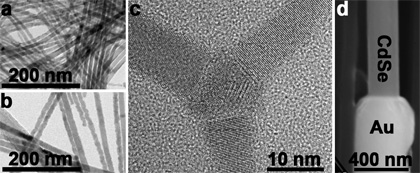
| Fig.3: Nanowires represent the extreme case of elongation, in which the particle length can be orders of magnitude greater than the diameter. A powerful method of solution-based nanowires synthesis, called the Solution-Liquid-Solid (SLS) method uses precursors similar to those used in normal colloidal growth in the presence of metal catalyst seed particles which serve as the medium for unidirectional growth. By varying the conditions, it is possible to produce a range of structures including, e.g., smooth (a) and rough-edged (b) PbSe wires. Structures that include an interface with the metal, such as three PbSe ‘arms’ on a Bi particle (c), or a semiconductor/metal nanowire/nanowire hybrid nanostructure (d) may lead to facile creation of low-resistance contacts in devices. |
Magnetically active nanoparticles
Another key advantage of colloidal synthesis is the flexibility to create unique material combinations that bring together multiple functionalities. One example of this is the creation of magneto-optical nanomaterials, in which magnetically-active species (either individual high-spin ions or nanosized metal domains) are incorporated directly into an optically active semiconductor nanostructure (Fig.5-6). The results are bifunctional materials that often display interesting interplay between the observable effects, ranging from simple magnetic switching of emission to tunable exchange interactions between semiconductor- and metal-based electronic states.

| Fig.5: These Co/CdSe core/shell nanocrystals are a unique bifunctional magneto-optical material that largely maintains both the magnetism and fluorescence of the component materials, although both are noticeably modified by intraparticle interaction. For instance, while the coercivity of the Co core particle was found to be unchanged by shell formation, the blocking temperature for the composite structure was observed to be substantially lower (Co: >350 K; Co/CdSe: 240 K). In addition, at low temperatures (20 K) shell CdSe photoluminescence (PL) decay was very rapid (<1 ns as compared to 20-30 ns for ordinary CdSe). |
Plasmonic hybrid materials
Another example of bifunctional materials also involves metals and semiconductors, but in this case hoping to harness the power of plasmonic metal nanostructures to modify the static and dynamic optical properties of nearby QDs (Fig.7). Full exploitation of these interactions requires careful control over a number of parameters that effect the spectral overlap of the metal nanoparticle plasmon feature(s) and the QD absorption or emission band, as well as the separation distance between the two particles. Thus, it is the perfect testbed for proving the flexibility and generality of colloidal synthesis methods.
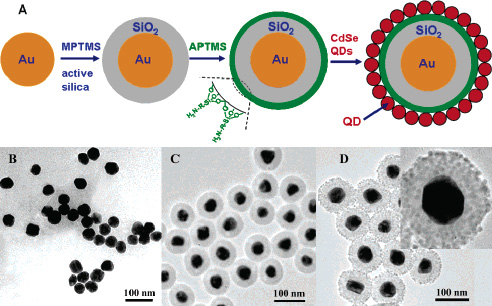
| Fig.7: In a stepwise process, discrete, dispersible hybrid nanoparticles are built up from colloidally synthesized Au nanoparticles. The Au cores are coated with a controlled thickness of SiO2, and then CdSe QDs are attached. The size of the Au core and the CdSe QDs controls the degree of spectral overlap between corresponding spectral features, and thickness of the SiO2 spacer determines the interaction distance. |
New Materials
The topical area that is conceptually simplest, but often proves most difficult in practice, is the development of QDs of new materials, by which we usually mean known bulk materials of interest for which current QD syntheses are inadequate or even nonexistent. Because of our extensive work in solar cells, materials with band gaps in the near-infrared are of particular interest (Fig.8). The establishment of a new material in QD form is a tremendous opportunity for fundamental insight, as the introduction of quantum confinement and unpredictable surface effects can produce very new and unexpected optical properties.
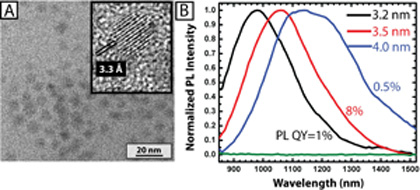
| Fig.8: A recent example of a new material is colloidal Ge QDs. In this effort, GeI2 was reduced by n-BuLi in the presence of 1-octadecene to produce highly-crystalline and surprisingly stable Ge NCs with octadecyl surface passivation. These new QDs were the first to show significant fluorescence in the infrared, as would be expected from Ge’s bulk band gap of 0.7 eV. This was especially interesting because it supports the often stated but not completely proven conjecture that quantum-confined nanocrystals of indirect gap materials (like Ge) should show some degree of direct-gap behavior. |

Fig.1: Because of the relative alignment of valence and conduction bands of the two materials, when “giant” quantum dots (gQDs) absorb light, the excited holes are confined to the central CdSe ‘core’, while excited electrons leak substantially out into the thick CdS ‘shell.’ The resulting charge-separated excited state results in a dramatic reduction in the efficiency of Auger recombination, which manifests in near-complete suppression of the fluorescence intermittency (or ‘blinking’), a well known problem in the use of QDs as fluorophores.

Fig.2: This type of carrier separation is also seen in a novel infrared-active nanostructure based on PbSe. In the past, creating nanoheterostructures including PbSe proved to be difficult, as the properties of PbSe QDs (as cores) would degrade at the elevated temperatures used to grow shells. However, reaction of large PbSe QDs with cadmium precursors, like cadmium oleate, results in a partial ion exchange that produces a QD with a smaller PbSe core and a CdSe shell that is amenable to further heterostructuring. Reaction of this new structure with cadmium and sulfur precursors can produce either an additional shell of CdS, or CdS “arms” to form a tetrapod structure. In either case, some degree of carrier separation in the excited state is evident, as radiative lifetime increases 1-2 orders of magnitude, to as long as 80 microseconds!
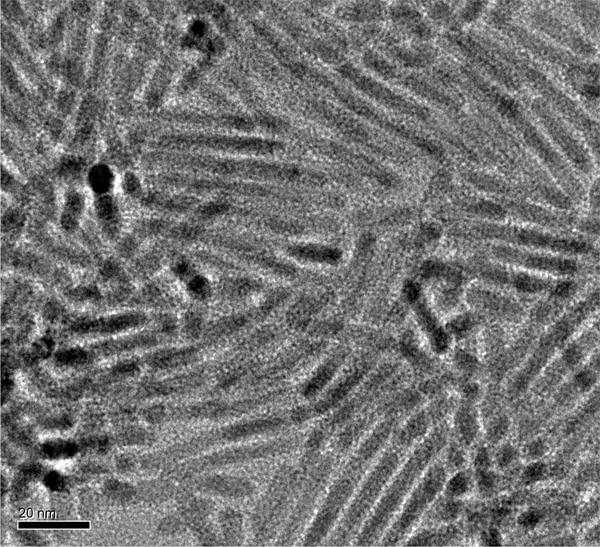
Fig.4: Nanorods are particularly interesting because of their potential to straddle the boundary between 2D and 3D confinement regimes as the length approaches and exceed the Bohr radius for a given material. Nanorods are typically produced by modified colloidal growth methods in which a specific ligand, such as a alkylphosphonic acid, is added to preferentially arrest or enhance growth in particular directions relative to the inherent crystal structure of the material to produce asymmetrical growth (scale bar 20 nm).
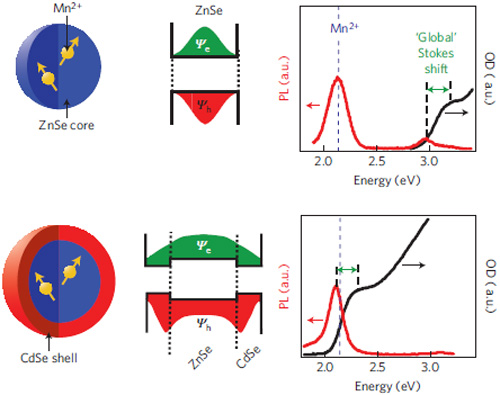
Fig.6: More subtle effects are observed when QDs are doped with magnetic ions. In a study that combines the introduction of magnetic functionality with the band-engineering of advanced heterostructuring, we created ‘inverted’ core–shell nanocrystals composed of Mn2+-doped ZnSe cores overcoated with undoped shells of CdSe that demonstrate a widely tunable magnetic sp–d exchange interaction between the excitons and the paramagnetic Mn2+ ions. Magnetic circular dichroism studies reveal giant Zeeman spin splittings of the band-edge exciton that, surprisingly, are tunable in both magnitude and sign. Effective exciton g-factors are controllably tuned from -200 to +30 solely by increasing the CdSe shell thickness, demonstrating that strong quantum confinement and wavefunction engineering in this heterostructured nanocrystal system can be used to manipulate carrier–Mn2+ wavefunction overlap and the sp–d exchange parameters themselves.
